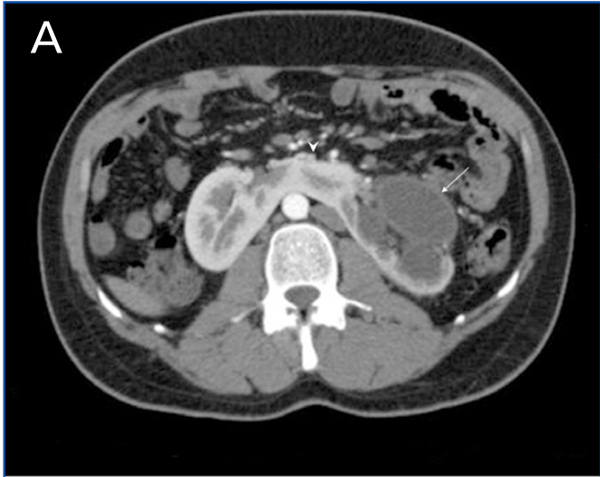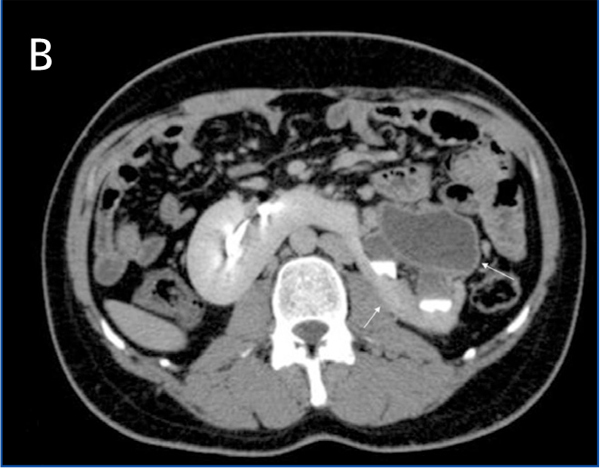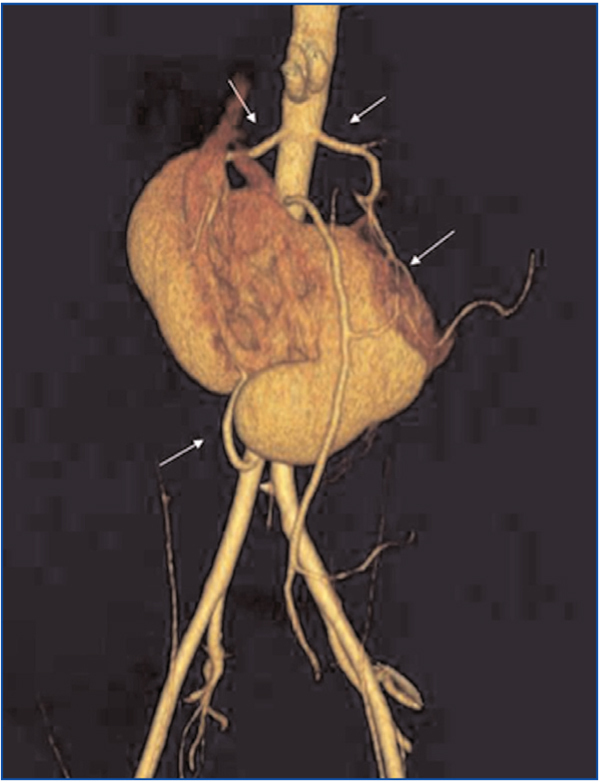To the Editor,
Horseshoe kidney (HK) was first described by Berengario da Carpo in 1552. Thirty-three percent of cases are asymptomatic and the remaining may present with complications such as multicystic renal dysplasia, obstructive uropathies, hydronephrosis, lithiasis, infections and neoplasias such as renal carcinoma and Wilms’ tumour or urothelial tumour.1
We present the case of a 27-year-old male, who came to the emergency department for abdominal pain located in the left flank. From his medical record, we discovered that he had a recent history of arterial hypertension (AHT). His blood pressure was 160/90mm Hg in the physical examination. We performed an abdominal ultrasound (not shown) in which cystic images were observed on the superior pole of the left kidney, which presented with a mild cortical atrophy. Given that a kidney disease was suspected, a computerised tomography (CT) scan was performed, showing that the cystic images corresponded to dilation of the pyelocaliceal system (Figure 1) in a HK (Figure 2). We performed a left pyeloplasty which resolved the obstructive problems: the patient being asymptomatic at present.
HK is the most common type of renal fusion anomaly. It appears in 1 out of every 400 births, with a higher incidence in men (2:1). The isthmus is usually located anterior to the large abdominal vessels. Hydronephrosis due to obstruction in the pyeloureteral junction is observed in a third of all HK, being factors which contribute to the upper ureter entering the renal pelvis and isthmus or blood supply anomalies.2 It has been documented that Wilms’ tumours, clear-cell, neuroendocrine,3 and urothelial carcinomas and nephroblastomas can be found in HK. It can be associated with congenital, genito-urinary, bone, gastrointestinal, myelomeningocele and cardiovascular anomalies. Pyeloureteral junction stenosis (PJS) is the most common congenital alteration of the upper urinary tract, and is most associated with HK. In most cases, PJS is due to a destruction of the muscular fibres and an increase in the amount of collagen in the pyeloureteral junction. The most common clinical sign is lumbar back pain, but for chronic obstruction, activation of the renin-aldosterone system would lead to vasoconstriction of the afferent arteriole, with a consequent reduction in renal blood flow and AHT developing. In spite of this, given hydronephrosis and HK, the most common cause is lithiasis, followed by PS.4 HK is diagnosed using imaging tests. CT with modern multidetectors can perform a multiplanar reconstruction and confirm the diagnosis given the ultrasound finding, whereas renal gammagraphy is used to find out whether the parenchyma is functioning correctly. Treatment is performed using laparoscopic and endoscopic pyeloplasty in any of its variants. At present, robotic surgery has proven its utility in obtaining good pyeloplasty results for primary and secondary stenosis, both for children and adults and for different causes.5
In summary, when a young patient presents with AHT (related or not to HK), one should consider that it may owe to a PJS. Abdominal CT scans are a good diagnostic method for assessing this condition.
Figure 1A. Abdominal CT scan after administering I.V. contrast agent. A) nephrogenic phase. Cystic formation in the left kidney at the height of the hilum (arrow). B) Excretory phase. The passage of the contrast agent is observed, confirming that it corresponds to d
Figure 1B. Abdominal CT scan after administering I.V. contrast agent. A) nephrogenic phase. Cystic formation in the left kidney at the height of the hilum (arrow). B) Excretory phase. The passage of the contrast agent is observed, confirming that it corresponds to d
Figure 2. 3D reconstruction of the previous test; horseshoe kidney with multiple accessory arteries (arrows).











